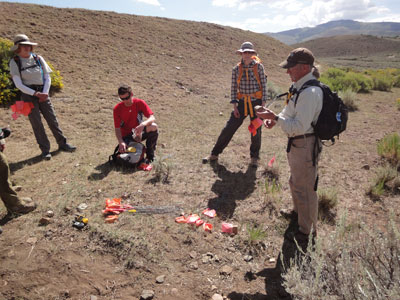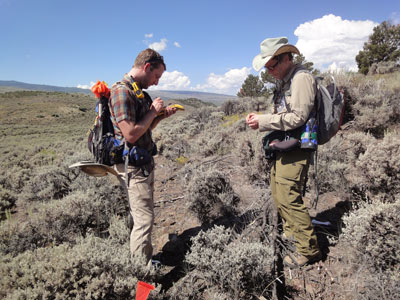Summer Training Survey
Each year the Office of the State Archaeologist of Colorado (OSAC) sponsors an archaeological inventory ("survey"), typically during the June-August period when few classes are scheduled. The survey provides field training in surveying techniques for PAAC volunteers, applicable toward certification requirements, and helps OSAC meet its statutory obligations to inventory land within Colorado. Previously undocumented archaeological and historical sites are discovered during the inventory, and added to OSAC’s database for use in future research.
Information about new discoveries is entered in digital format on GPS receivers. Field training involves hiking across undeveloped lands in search of artifacts and features more than fifty years old. When such sites are discovered, volunteers are instructed in the production of sketch maps, filling out standard recording forms, plotting site locations, artifact illustration, and other standard archaeological procedures. Credit toward certification is earned for the days spent under professional supervision (Certified Surveyor I), and for each site form which volunteers complete following the inventory (Provisional Surveyor). Final technical reports on the summer surveys held at the Pawnee Buttes in Weld County, Pike’s Stockade in Conejos County, Hermit Park in Larimer County, and Antelope Gulch in Fremont County describe the training survey program in greater detail as well as providing interpretations of those previous inventories.

2015 project director Curtis Martin describing a mano (seed grinding tool) discovered by Kristin Putnam.
In 2017, PAAC partnered with Paleocultural Research Group (PCRG) to conduct a survey of BLM and state lands along the Rio Grande River in southern Conejos County. The crews documented 60 new archaeological resources, including 28 new archaeological sites and 32 isolated finds. Additionally, 57 separate rock art panels at three different sites were documented in great detail, and test excavations occurred at three different sites. One of the test excavations salvaged four fire hearth features, all of which had datable remains that will be submitted for further analysis and dating of the site. Analysis of this project is just beginning and results and final report will be posted here when they are complete.
Because PAAC training sites are often in remote locations lacking public facilities of any sort, and involve hiking across somewhat rugged terrain, prospective participants must be in reasonably good physical condition. The ability to contend with hot summer days, bothersome insects, and generally primitive working conditions is a necessity. Usually volunteers must supply their own transportation, room and board, daypack and personal gear such as canteens, but this can vary by project and specific logistics will be provided. Aside from personal equipment (camping gear, pack) there is no base course fee for participation. The Office of the State Archaeologist of Colorado (OSAC) or its partners such as DARG or PCRG supply all surveying, recording and mapping equipment as well as the professional archaeologist(s) who supervises the volunteers.
Details on 2018 field projects are still being decided. A final project list will be posted here by mid-January 2018. For more information and to express your interest in volunteering for the survey, please contact the State Archaeologist at holly.norton@state.co.us or 303-866-3392.

